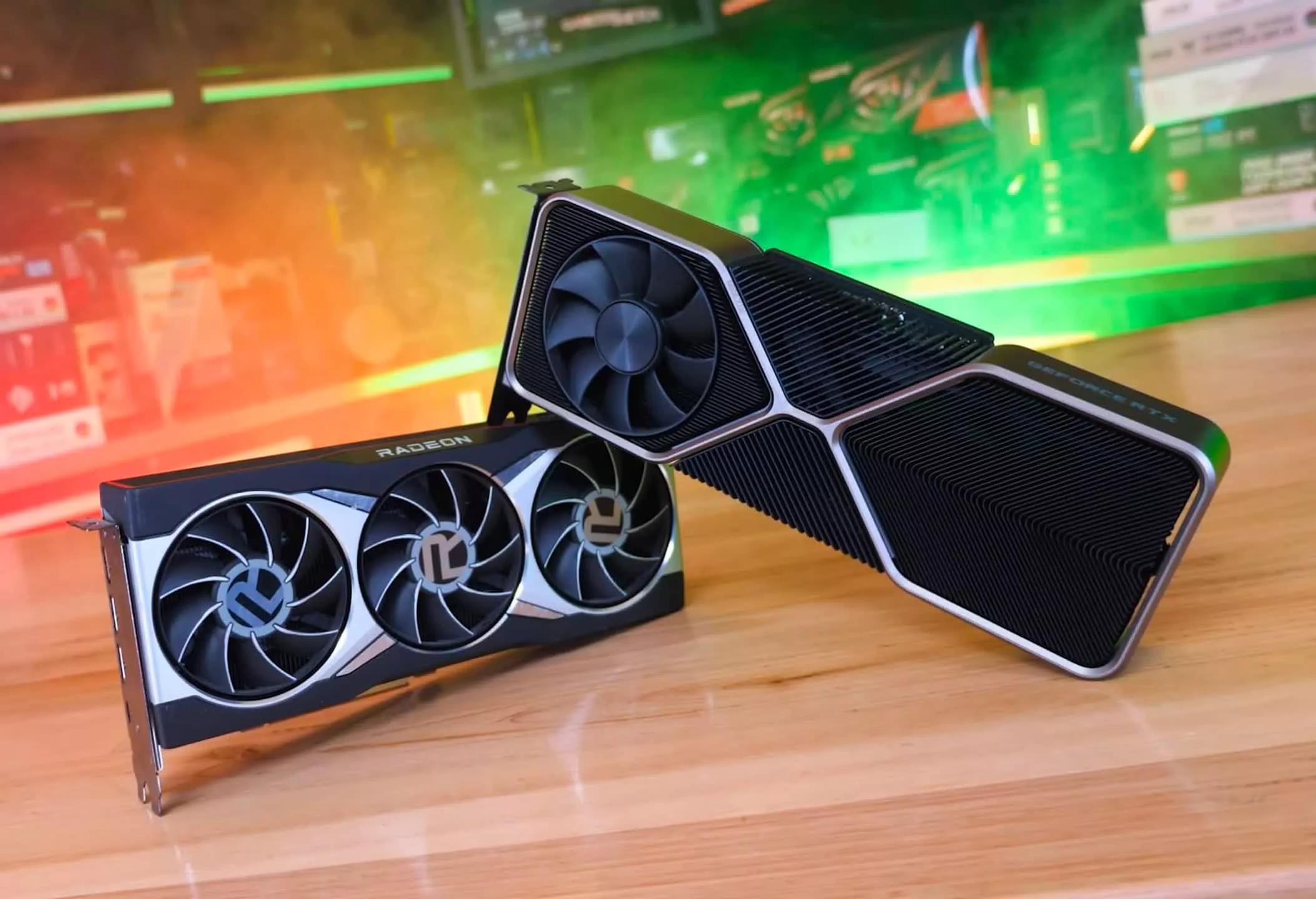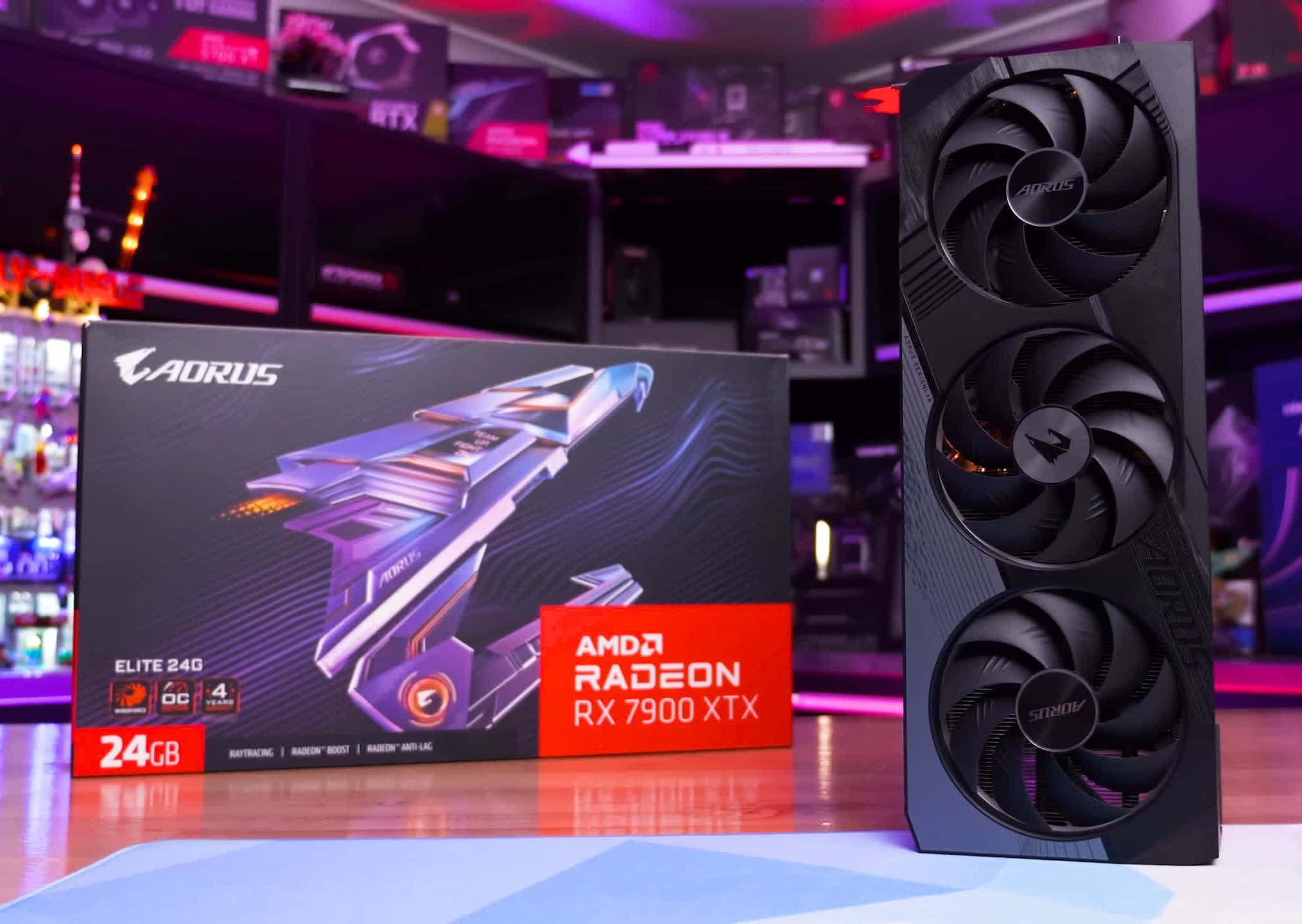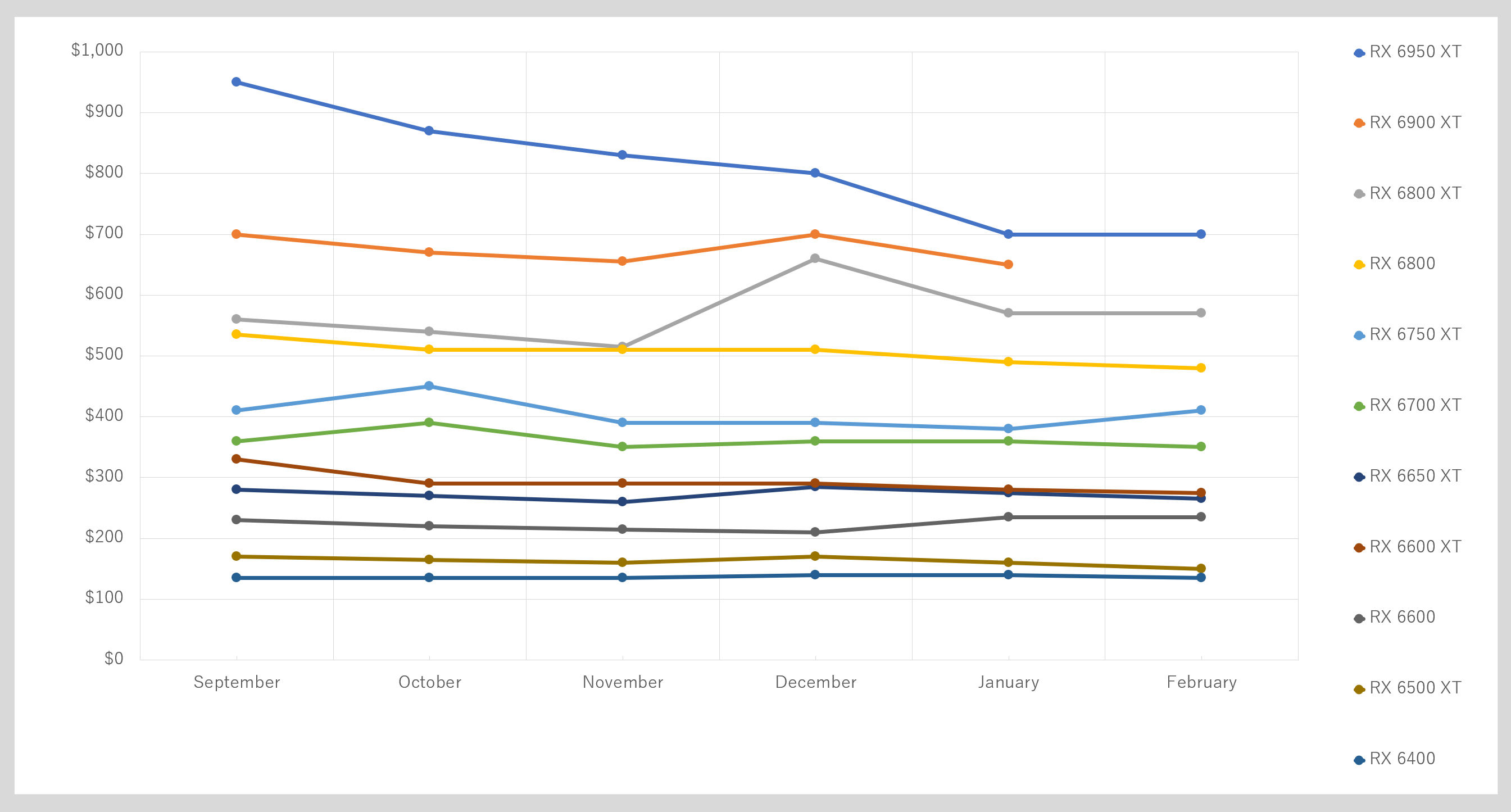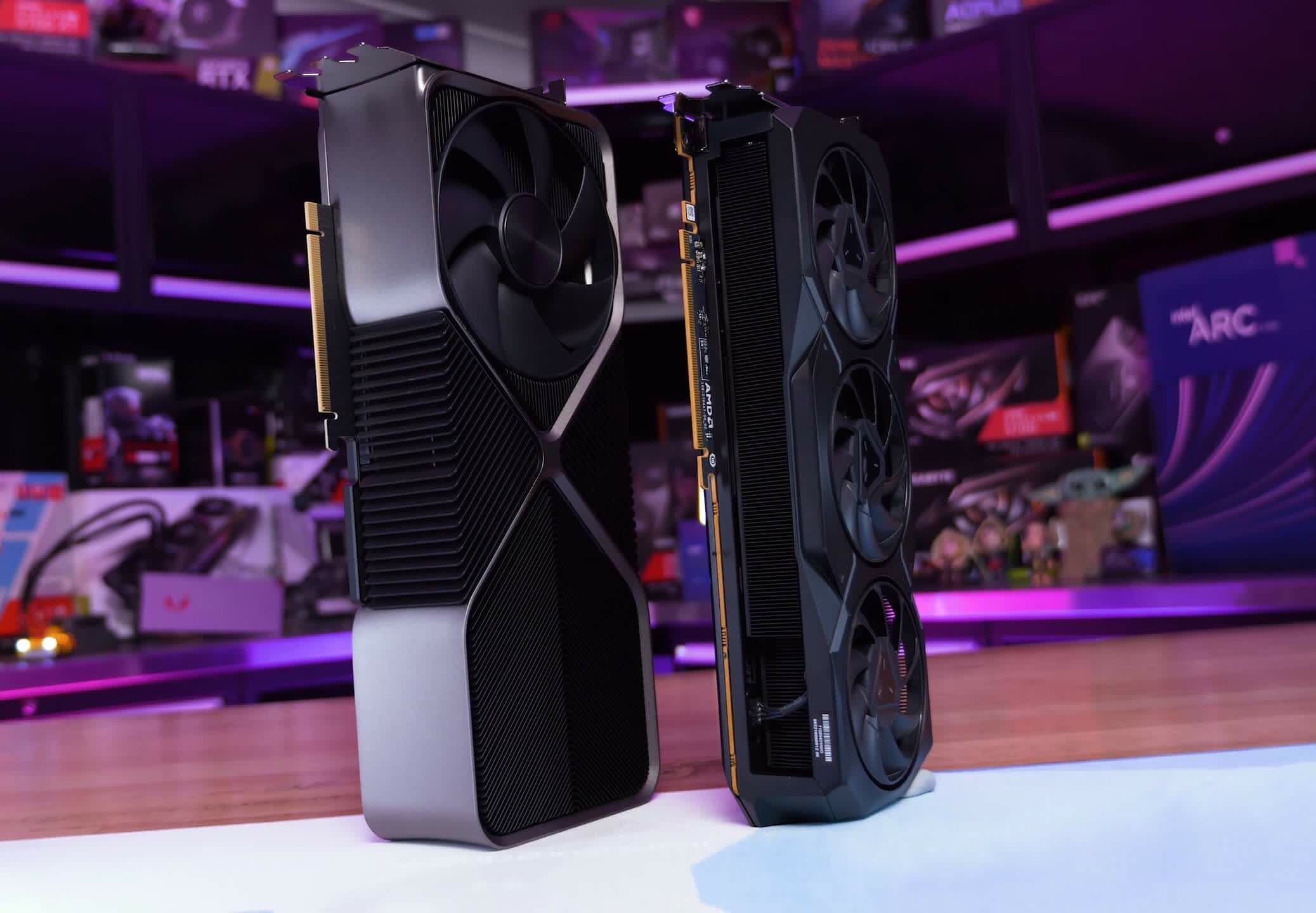After a period of consistent graphics card releases from Nvidia and AMD, things have cooled down in February. No new GPUs to talk about, no especially amazing deals or anything, but it's still worth taking a look at how the market is behaving now that it's settled down a bit, and what we can expect in the coming few months.
One of two key highlights in the past month: some lucky customers in the United States were treated to "clearance" prices at Best Buy for Nvidia GeForce 30 series cards. These included the RTX 3090 Ti dropping to $880, the RTX 3080 Ti falling to $720, and the RTX 3080 listed for an astonishingly low $420, down from its $700 MSRP.
Updated: See our latest GPU Pricing Update here.
While other mid-range cards saw no discounts, those that were able to pick up the RTX 3080 for $420 received a ripping good deal - and that's really one of the only ways to get a good deal in the current market if you are interested in an Nvidia GPU at this sort of performance tier.
What's interesting about this clearance pricing is that for the most part, despite being limited time deals, they really should just be the regular price for these graphics cards in 2023. Several of them, like the RTX 3060, are nearly two years old. Take the RTX 3090 Ti at its discounted price of $880. That may seem like a great deal considering the card launched at $2,000, but on a cost per frame basis it still makes the RTX 3090 Ti a relatively poor deal.
With the new GeForce RTX 4070 Ti coming in at $820 these days, the 3090 Ti at $880 actually has slightly worse cost per frame. Given that 4070 Ti cards have been abundant and easy to purchase, there's no real reason to wait for the 3090 Ti to drop to $880, unless you specifically needed the 24GB of VRAM vs just 12GB on the 4070 Ti. In our opinion, in the current market a 3090 Ti-like GPU would need to be priced closer to $700 to pique our interest. That would give it superior value than the Radeon 6950 XT and for a clearance price would make it an obvious buy.
A similar analysis can be applied to the RTX 3080 Ti, with its discounted price of $720 looking like a good deal given the overpriced $1,200 MSRP. And while the 3080 Ti is indeed better value than the RTX 3090 Ti's clearance we just discussed, it isn't anything too special either. We're looking at a mere 2% discount in cost per frame relative to the current price for the Radeon 7900 XT and just 6% discount compared to the RTX 4070 Ti. It also falls short of the value delivered by the Radeon 6950 XT.
The worst clearance "discount" was for the RTX 3060 though, even at $300 it simply isn't worth buying compared to the Radeon 6650 XT which delivers similar performance at $265 - and that price has remained steady for several months now. A true clearance price for the RTX 3060 would have to be closer to $250 or even $230.
However, those who snapped up the RTX 3080 for $420 got a great deal. At this low price the RTX 3080 is clearly the best graphics card on the market in cost per frame, delivering the performance of the Radeon 6800 XT which AMD is selling these days for $570, but giving that to you for a 26 percent discount. That's a true clearance price and it's no surprise to see it selling out instantly.
These clearance prices and the news surrounding it highlights something to keep in mind when purchasing a new or discounted GPU. Even if the price is slashed compared to the original MSRP (from 2020 or 2021), it may not actually be a good buy in 2023. Many other GPUs have fallen in price, particularly on the AMD side, and we've got new offerings in the market in the RTX 40 and Radeon 7000 series. It's always worth assessing the entire market before jumping in, otherwise you may end up with an RTX 3090 Ti when you should have bought an RTX 4070 Ti.
Is Nvidia Restricting RTX 4090 Supply?
The second interesting story that's been making the rounds is the rumor that Nvidia is restricting RTX 4090 supply so that gamers are forced into buying the RTX 4080 instead, which remains in abundant supply as no one wants it. This comes from Moore's Law is Dead, citing several sources.
Based on our understanding, lower RTX 4090 supply isn't a new thing. This has been the case since launch week. Most retailers received a significant supply of these GPUs at launch, more than usual for a high-end product, while subsequent shipments have been on the smaller side. It's unclear whether this is a reaction to the RTX 4080 and Nvidia wanting people to buy that instead, or it was the same plan since day one.
What we're sure of is that any plan to restrict RTX 4090 supply in the hopes of shifting RTX 4080s probably won't work, not unless pricing is made more attractive. For months now the RTX 4080 has been easy to get at the MSRP, while the RTX 4090 has been largely out of stock in some countries, or priced above its MSRP. Gamers have had ample chances since the beginning of the year to buy the RTX 4080 instead of an impossible to find RTX 4090, and have largely chosen not to do.
But there are more reasons why we don't think this would work. First, the Radeon RX 7900 XTX has been slowly working its way back into stock, and can currently be purchased for $1,050, which is $50 above its $1,000 MSRP but down from last month's price of nearly $1,300. If Nvidia is driving people away from their premium RTX 4090 and into the $1,200 tier, there is actual competition to be found there from AMD, and we suspect many buyers will be more interested in the cheaper, better value 7900 XTX than the overpriced RTX 4080. Typically companies would rather sell higher priced products with no competition, so that would be an odd move.
Also, the GeForce RTX 4090 is actually available in many countries, just not so much in the United States, which tends to be the focus of most of these discussions. In Australia you can actually buy a 4090 right now for below the local MSRP of $2,960 AUD, so that isn't going to force anyone into buying an RTX 4080 instead. In countries like Canada and the UK, you're looking at just a 5 percent premium over MSRP to buy a 4090, compared to 13% or more in the US, which isn't going to make much of a difference to someone who has the cash for a premium GPU like this.
Whether or not this will change remains to be seen. Maybe the models that are in stock are all that is coming for a little while, but RTX 4090 sales have cooled down so we don't expect a huge imminent supply crunch, at least outside the US. Moreover, with the RTX 4090 being significantly faster than the RTX 4080, we imagine those that want all that performance would rather wait until stock is replenished than changing their mind and buying the inferior product instead.
Nvidia GeForce GPU Pricing
| MSRP | Lowest Price December | Lowest Price January | Lowest Price February | Current Price Inflation | Increase Jan to Feb | |
|---|---|---|---|---|---|---|
| GeForce RTX 3090 Ti | $2,000 | No stock | No stock | No stock | n/a | |
| GeForce RTX 3090 | $1,500 | No stock | No stock | No stock | n/a | |
| GeForce RTX 3080 Ti | $1,200 | No stock | No stock | No stock | n/a | |
| GeForce RTX 3080 12GB | n/a | No stock | No stock | No stock | n/a | |
| GeForce RTX 3080 10GB | $700 | No stock | $840 | No stock | n/a | |
| GeForce RTX 3070 Ti | $600 | $640 | $650 | $620 | 3% | -5% |
| GeForce RTX 3070 | $500 | $570 | $570 | $545 | 9% | -4% |
| GeForce RTX 3060 Ti | $400 | $390 | $410 | $410 | 2% | 0% |
| GeForce RTX 3060 | $330 | $360 | $340 | $330 | 0% | -3% |
| GeForce RTX 3050 | $250 | $270 | $280 | $280 | 12% | 0% |
| Average | 5% | -2% |
Graphics card supply is always a tricky discussion because gamers want these GPUs to flood the market, so that prices drop overnight, but companies will try to manage supply so that doesn't happen; they want supply to meet demand. GPU makers also have to manage their GPU and wafer allocation across many products. For example, in the short term while RTX 4090 demand has dropped off, Nvidia may be choosing to focus on the recently released workstation RTX 6000 Ada card instead, which commands a much higher price tag. That's just normal resource management and isn't anything to be concerned about.
Outside of the occasional discount and flash sale, the reality is that new GPU pricing hasn't shifted substantially in the last six months, and the release of new graphics cards – at largely the same cost per frame as older models – has done little to shake up the market.
Nvidia has made no effort to bring their older Ampere GPUs back to their MSRPs despite a relatively weak GPU market. The RTX 3070 has routinely sat above $500 for the last five months, as has the RTX 3070 Ti with its $600 MSRP. The RTX 3050 is still terribly priced at nearly $300 when it should be no more than its $250 MSRP – ideally less. The RTX 3060 for the first time in the past year is available at its $330 MSRP, while the 3060 Ti has been the only model that we'd say has had a realistic MSRP.
... if buyers voting with their wallets are saying these cards are good value, then it's unlikely we'll see a significant shake-up with new models.
For buyers interested in a mid-range GPU, this is an ugly picture and it's hard to recommend any of these Nvidia GPUs except maybe the RTX 3060 Ti. Most of these GPUs are several years old now, we're approaching the launch of new RTX 40 mainstream models in the coming months, and AMD has dropped pricing for their competing cards below MSRP. Despite this, cards like the RTX 3060 and RTX 3050 continue to sell at a reasonable pace, which doesn't bode well for the mainstream market this year – if buyers voting with their wallets are saying those cards are good value, then it's unlikely we'll see a significant shake-up with new models.
AMD Radeon GPU Pricing
| MSRP | Lowest Price December | Lowest Price January | Lowest Price February | Current Price Inflation | Price Increase Jan to Feb | |
|---|---|---|---|---|---|---|
| Radeon 6950 XT | $1,100 | $800 | $700 | $700 | -36% | 0% |
| Radeon 6900 XT | $1,000 | $700 | $650 | No stock | n/a | |
| Radeon 6800 XT | $650 | $660 | $570 | $570 | -12% | 0% |
| Radeon 6800 | $580 | $510 | $490 | $480 | -17% | -2% |
| Radeon 6750 XT | $550 | $390 | $380 | $410 | -25% | 8% |
| Radeon 6700 XT | $480 | $360 | $360 | $350 | -27% | -3% |
| Radeon 6650 XT | $400 | $285 | $275 | $265 | -34% | -4% |
| Radeon 6600 XT | $380 | $290 | $280 | $275 | -28% | -2% |
| Radeon 6600 | $330 | $210 | $235 | $235 | -29% | 0% |
| Radeon 6500 XT | $200 | $170 | $160 | $150 | -25% | -6% |
| Radeon 6400 | $160 | $140 | $140 | $135 | -16% | -4% |
| Average | -25% | -1% |
On the AMD side, pricing has also been flat over the last six months, especially for mainstream offerings priced below $400. Higher end models have fallen in price, as AMD looked to clear inventory for their Radeon 7000 series, though unlike Nvidia, most of these GPUs are still available. The one outlier here is the 6800 XT which has fluctuated in price more than usual. During the holidays there were some very attractive sales for that model, but now stock is harder to come by and prices have risen a bit.
Radeon Pricing Trend
It's easier to make a case to buy an AMD GPU in the current market. For example, the Radeon 6950 XT is still reasonably priced at $700, offering better cost per frame than the RX 7900 XT and XTX, though at a lower performance tier. You could also make a case for most other models as they are typically among the better value products on the market, such as the Radeon 6700 XT, 6650 XT, 6600 and 6800 XT.
However, you could also say that AMD GPUs are priced where they are for a reason. Nvidia's stronger feature set commands a price premium over an equivalently performing AMD GPU, though we do think in lower performance categories that baseline GPU performance is the most important factor, especially as ray tracing on an RTX 3060 isn't something you should care about much. AMD has also made a few blunders lately, such as not releasing a new driver for the Radeon 6000 series for two months – that left RDNA2 owners feeling a bit ignored from the software side – a baffling move from Team Red.
Used GPU Pricing
The used market has also seen few price movements as a result of a flat new market. RTX 3090 Ti prices have fallen since December, but outside of that there isn't much going on here to suggest you'll be getting a much better deal a few months from now. The used market does have a few gems depending on what you're after though...
| MSRP | Newegg Lowest Price February | eBay Used Price January | eBay Used Price February | Used Price Hike Jan to Feb | Discount Used vs New | |
|---|---|---|---|---|---|---|
| GeForce RTX 3090 Ti | $2,000 | No stock | $978 | $953 | -3% | |
| GeForce RTX 3090 | $1,500 | No stock | $762 | $777 | 2% | |
| GeForce RTX 3080 Ti | $1,200 | No stock | $744 | $722 | -3% | |
| GeForce RTX 3080 12GB | n/a | No stock | $601 | $629 | 5% | |
| GeForce RTX 3080 10GB | $700 | No stock | $558 | $524 | -6% | |
| GeForce RTX 3070 Ti | $600 | $620 | $482 | $473 | -2% | -24% |
| GeForce RTX 3070 | $500 | $545 | $384 | $368 | -4% | -33% |
| GeForce RTX 3060 Ti | $400 | $410 | $319 | $323 | 1% | -21% |
| GeForce RTX 3060 | $330 | $330 | $273 | $271 | -1% | -18% |
| GeForce RTX 3050 | $250 | $280 | $221 | $221 | 0% | -21% |
| Average | -1% | -23% |
| MSRP | eBay Average Price December | eBay Average Price January | eBay Average Price February | Current Price Inflation | Price Increase Jan to Feb | |
|---|---|---|---|---|---|---|
| GeForce GTX 1660 Ti | $280 | $132 | $139 | $137 | -51% | -2% |
| GeForce GTX 1660 Super | $230 | $124 | $130 | $129 | -44% | 0% |
| GeForce GTX 1660 | $220 | $116 | $111 | $114 | -48% | 3% |
| GeForce GTX 1650 Super | $160 | $113 | $107 | $119 | -26% | 11% |
| GeForce GTX 1650 | $150 | $103 | $104 | $100 | -33% | -3% |
| Average | -40% | 2% |
For example, we find it hard to justify spending $550 on a new RTX 3070 these days, but you can get one used for just $370, which along with the RTX 3060 Ti at $320 is tempting if you want an Nvidia GPU. The gap in cost per frame between Nvidia and AMD closes on the used market and makes Nvidia options a bit more attractive than new. The GTX 16 series continues to offer something for people who have less than $150 to spend, while Turing models also seem decent, although the performance on offer is getting harder to recommend for the latest AAA titles.
| MSRP | Newegg Lowest Price February | eBay Used Price January | eBay Used Price February | Used Price Hike Jan to Feb | Discount Used vs New | |
|---|---|---|---|---|---|---|
| Radeon 6950 XT | $1,100 | $700 | $740 | $631 | -15% | -10% |
| Radeon 6900 XT | $1,000 | No stock | $621 | $585 | -6% | n/a |
| Radeon 6800 XT | $650 | $570 | $523 | $507 | -3% | -11% |
| Radeon 6800 | $580 | $480 | $428 | $405 | -5% | -16% |
| Radeon 6750 XT | $550 | $410 | n/a | n/a | n/a | n/a |
| Radeon 6700 XT | $480 | $350 | $312 | $309 | -1% | -12% |
| Radeon 6650 XT | $400 | $265 | n/a | n/a | n/a | n/a |
| Radeon 6600 XT | $380 | $275 | $221 | $204 | -8% | -26% |
| Radeon 6600 | $330 | $235 | $180 | $170 | -5% | -28% |
| Radeon 6500 XT | $200 | $150 | n/a | $118 | n/a | -21% |
| Radeon 6400 | $160 | $135 | n/a | n/a | n/a | n/a |
| Average | -6% | -18% |
Used AMD Radeon GPUs are harder to recommend at times, mostly because if you're buying something like a Radeon 6800 XT you won't be saving that much compared to just buying that model new. I certainly wouldn't be grabbing a used graphics card for a mere 10% discount – we'd want at least 20% off to compensate for the absence of warranty and any potential issues. The Radeon 6600 for just $170 used, for example, is a ripping deal.
| MSRP | eBay Average Price December | eBay Average Price January | eBay Average Price February | Current Price Inflation | Price Increase Jan to Feb | |
|---|---|---|---|---|---|---|
| Radeon 5700 XT | $400 | $172 | $171 | $164 | -59% | -4% |
| Radeon 5700 | $350 | $141 | $152 | $136 | -61% | -10% |
| Radeon 5600 XT | $280 | $132 | $131 | $129 | -54% | -1% |
| Radeon 5500 XT 8GB | $200 | $113 | $111 | $104 | -48% | -6% |
| Average | -55% | -6% |
The Radeon 5000 series might also be worth considering as prices continue to fall there. The 5700 XT for $164 on average is cheap, as it's a similar price to the Radeon 6600 used while performing more like a 6600 XT. You do lose the ability to run ray tracing, but this isn't relevant on an entry-level GPU.
Wrap Up
The overall GPU market hasn't changed much in the last six months. The middling reception to new graphics cards, their similar cost per frame to existing models, and generally expensive pricing hasn't shaken up the market at all – aside from a few price drops here and there. There has been no pressure on the midrange and entry level markets, so buyers in that segment have been faced with stagnation since mid-2022.
For high end buyers, both AMD and Nvidia have launched their most expensive models, and stock for most GPUs is settling to a normal level. We wouldn't expect much price movement there. Nvidia is holding firm on RTX 4080 pricing despite terrible sales volumes, and AMD models are too new to start drastically coming down in price. As was the case last month, the two most in demand models – the GeForce RTX 4090 and Radeon RX 7900 XTX – are likely to remain at their MSRP for some time, barring an unexpected RTX 4080 price drop causing additional competition.
Both AMD and Nvidia have talked about weak demand for consumer components in their latest earnings reports and the strategy for now appears to hold firm, reduce supply to match reduced demand, and keep sailing in the same direction.
For the mid-range and mainstream markets there's not much to get excited about. Pricing has been the same for a while now, new offerings/replacements are still months away, and the new models may not be mid-range cards anyway. The rumors surrounding these upcoming models don't paint a particularly awesome picture. We may see a small improvement in price-to-performance and that's it, which would be overly disappointing but regrettably that's been the last five years of GPUs.







